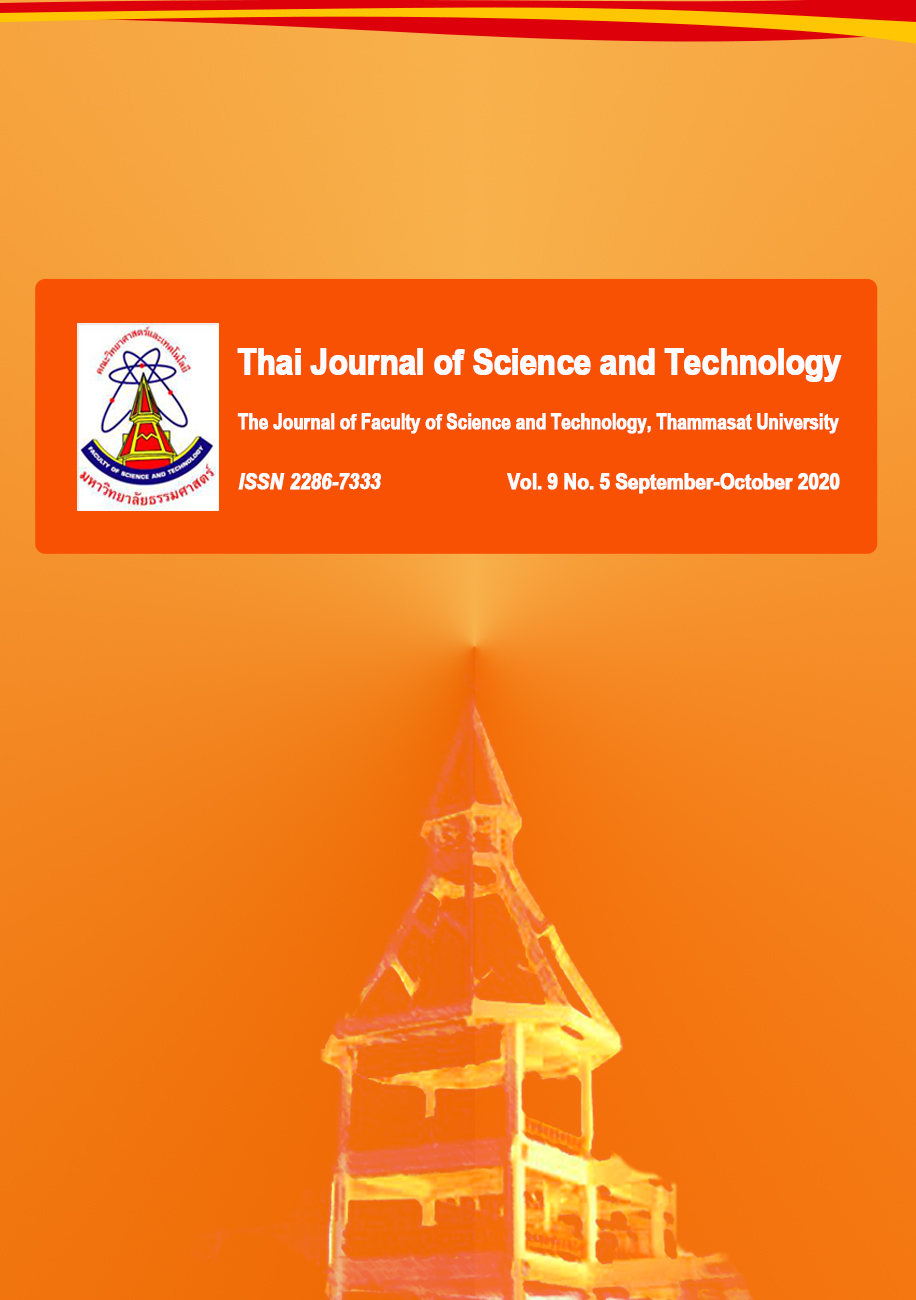ชีวผลิตภัณฑ์ย่อยสลายสารเคมีกำจัดศัตรูพืชในกลุ่มไพรีทรอยด์ ออร์กาโนฟอสเฟต และคาร์บาเมต
Main Article Content
Abstract
Development of bioproduct for degradation pesticide residues in agricultural soil, with beneficial bacteria that are effective in degrading 3 groups of pesticides, i.e. strain SP-TU-C (pyrethroid group degrading), SP-TU-15-2 (organophosphate group) and SP-TU 2-12Y (carbamate group), was conducted. The beneficial bacteria were encapsulated by the spherification method, and later used as a leavening agent for increasing their amount. To increase the number of the beneficial bacteria, three formulas of the media, i.e. (1) TU-F1 (10 g of yeast, 1 L of water), (2) TU-F2 (5 g of yeast, 2.5 g of rice bran, 1 L of water), and (3) TU-F3 (1 g of yeast, 1 g of rice bran, 1 g of ground soybean, 1 L of water) were developed and compared with the standard medium (nutrient glucose broth, NGB). The averaged population of beneficial bacteria strain SP-TU-C, SP-TU-15-2, and SP-TU 2-12Y were 1.59 x 1023, 3.50 x 1023, and 2.1 x 1023 CFU/mL, respectively. The TU-F1 formula was used to study the optimum duration of bacterial culturing. The experimental design was completely randomized design (CRD) with 3 replications, where 10 g of bacterial encapsulate were added to 1 L of TU-F1 formula. The results revealed that the bacteria were grown well, where the lag and log phases were within 3 hours, and entered to stationary phase from 3 to 48 hours after cultured. The shelf life of bioproducts recorded after storage at 5±2 °C for 3 months was revealed that the population of beneficial bacteria of SP-TU-C, SP-TU-15-2 and SP-TU 2-12Y were still stable as 1.0 x 1023, 3.0 x 1023 and 9.6 x 1022 CFU/mL, respectively. Longer shelf life should be further confirmed the effectiveness of the developed bioproducts, and the degradation efficiency under field conditions.
Article Details
บทความที่ได้รับการตีพิมพ์เป็นลิขสิทธิ์ของคณะวิทยาศาสตร์และเทคโนโลยี มหาวิทยาลัยธรรมศาสตร์ ข้อความที่ปรากฏในแต่ละเรื่องของวารสารเล่มนี้เป็นเพียงความเห็นส่วนตัวของผู้เขียน ไม่มีความเกี่ยวข้องกับคณะวิทยาศาสตร์และเทคโนโลยี หรือคณาจารย์ท่านอื่นในมหาวิทยาลัยธรรมศาสตร์ ผู้เขียนต้องยืนยันว่าความรับผิดชอบต่อทุกข้อความที่นำเสนอไว้ในบทความของตน หากมีข้อผิดพลาดหรือความไม่ถูกต้องใด ๆ
References
นันทิกา สุนทรไชยกุล, 2560, ปัจจัยกำหนดการรับรู้ความเสี่ยงเกี่ยวกับการใช้สารเคมีกำจัดศัตรูพืชของชาวนาในอำเภอหนองฉาง จังหวัดอุทัยธานี, ว.ความปลอดภัยและสุขภาพ 10(1): 21-34.
พัชรี คำประเวช และสุธีรา วัฒนกุล, 2561, การผลิตเม็ดบีดส์น้ำเสาวรสด้วยเทคนิครีเวิร์สสเฟียริฟิเคชัน, ว.วิทยาศาสตร์และเทคโนโลยี 26(8): 1382-1393.
มาลินี ลิ้มโภคา, 2527, พิษวิทยาและปัญหาที่พบในสัตว์, โรงพิมพ์จรัลสนิท, กรุงเทพฯ, 397 น.
สุธาสินี อั้งสูงเนิน, 2558, ผลกระทบต่อสิ่งแวดล้อมจากการใช้สารเคมีกำจัดศัตรูพืช, ว.วิชาการมหาวิทยาลัยอีสเทิร์นเอเชีย ฉบับวิทยาศาสตร์และเทคโนโลยี 9(1): 50-63.
Chandramoulia, V., Kailasapathya, K., Peirisp, P. and Jones, M., 2004, An improved method of micro- encapsulation and its evaluation to protect Lactobacillus spp. in simulated gastriccondition, J. Appl. Microbiol. 56: 27-35.
Costa, E., Usall, J., Teixido, N., Garcia, N. and Vinas, I., 2000, Effect of protective agents, rehydrationmedia and initial cell concentration on viability of Pantoea agglomerans strain CPA-2 subjected to freeze-drying, J. Appl. Microbiol. 89: 793-800.
Doumeche, B., Kuppers, M., Stapf, S., Blumich, B., Hartmeier, W. and Ansorge-Schuma cher, M.B., 2004, New approaches to visualization, quantification and explanation of acid-induced waterloss from Ca-alginate hydrogel beads, J. Microencapsulat. 21: 565-573.
Liew, S.L., Ariff, A.B. Raha, T.A.R. and Hoa, Y.W., 2005, Optimization of composition for the production of a probiotic microorganism, Lactobacillus rhamnosus, using response surface methodology, J. Food Microbiol. 102: 137-142.
Morgan, C.A., Herman, N., White, P.A. and Vesey, G., 2006, Preservation of micro- organisms by drying, J. Microbiol. Methods 66: 183-193.
Siriwong, W., Thirakhupt, K., Sitticharoenchai, D., Borjan, M. and Robson, M., 2008, Organochlorine pesticide residues in plankton, Rangsit agricultural area, Central Thailand, J. Toxicol. Environ. Health Sci. 81: 608-612.


